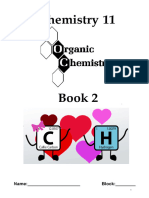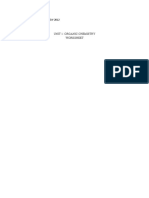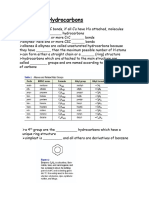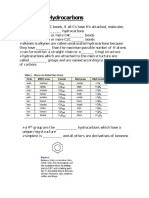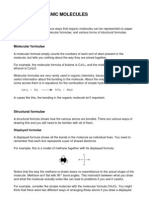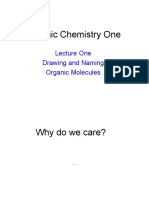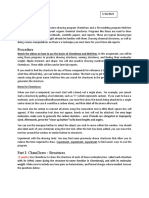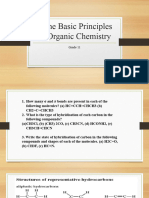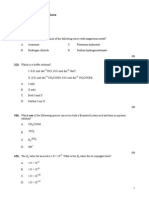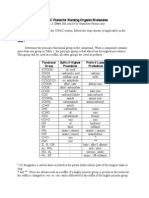Isomerism in Alkanes, Cycloalkanes, and Alkenes Using Molecular Models
Isomerism in Alkanes, Cycloalkanes, and Alkenes Using Molecular Models
Uploaded by
albertvdatu278Copyright:
Available Formats
Isomerism in Alkanes, Cycloalkanes, and Alkenes Using Molecular Models
Isomerism in Alkanes, Cycloalkanes, and Alkenes Using Molecular Models
Uploaded by
albertvdatu278Original Title
Copyright
Available Formats
Share this document
Did you find this document useful?
Is this content inappropriate?
Copyright:
Available Formats
Isomerism in Alkanes, Cycloalkanes, and Alkenes Using Molecular Models
Isomerism in Alkanes, Cycloalkanes, and Alkenes Using Molecular Models
Uploaded by
albertvdatu278Copyright:
Available Formats
EXPERIMENT
Isomerism in Alkanes, Cycloalkanes, and Alkenes using Molecular Models
Materials Needed - Molecular model kit PRE-LABORATORY QUESTIONS 1. Draw structural formulas of (a) n-hexane (b) 1-hexene (c) cyclohexane (d) cyclohexene.
2. Which if any of the above are isomers of each other? Explain your answer fully.
Constitutional Isomerism 1. Positional Isomerism of Haloalkanes. The models you will prepare in this section require four different items from the kit: tetrahedral carbons, hydrogens, chlorines, and sticks for single bonds. A. Methanes. Make a model for each of the following structures:
Are all four of the above superimposable on each other? ______ Do the four formulas represent different molecules? ______ Now make a model for each of the following structural formulas:
Are all four of the models superimposable on each other? ______ Do the four formulas represent different molecules? ______ Chloroform is CHCl3. How many different molecules are possible for CHCl3? ______ B. Ethanes. Prepare models of each of the molecules shown below..
Are the two models superimposable? Remember that rotation of the C-C bond easily occurs. ______ Are the two molecules isomers or the same compound? ______ What is the IUPAC name of this compound? ________________________________
Now rearrange one of the models to form the molecule shown below.
Is the new model superimposable on the one you did nothing to? __________ What is the name of the compound represented by the new model? __________________________ You now have models of two molecules that are isomers of each other: they are different compounds (with different names) that have the same molecular formula (C2H4Cl2). Furthermore, because the only difference in their structures is the position of a substituent (the chlorine) these isomers are considered to be positional isomers of each other. Post-lab assignment: Using a chemical handbook or internet reference source to fill out the following table illustrating the different physical properties of these two compounds. Compound Name literature boiling point (C) literature melting point (C)
Reference used ____________________________________________________________________ C. Propanes. Prepare a model of propane, C3H8. Can the three carbons and eight hydrogens be arranged to form more than one different molecular structure that are not merely different conformations of the same compound? ____________ Now replace any one hydrogen attached to an end carbon on the molecule with a chlorine atom. Draw the structural formula for the molecule in the space below, and label it with its proper name.
Prepare another propane molecule and then replace any one hydrogen attached to the middle carbon with a chlorine atom. Draw its structural formula, and label it with its proper name.
Are the two chloropropane molecules that you have just prepared superimposable? __________ Are they isomers? _________ If so, what type of isomerism do they exhibit? ________________ D. Butanes. Replace the chlorine atoms in your two chloropropane molecules with methyl (CH3) groups. Draw structural formulas for the two positional isomers of butane you have just prepared, and give IUPAC names for them.. Note that one of the isomers contains an unbranched carbon chain while the other has a branch in the middle. The unbranched isomer is commonly called n-butane while the branched molecule is called isobutane . For each of the structures below, indicate whether it is n-butane, isobutane, or neither.
_________________
______________
______________
_________________
_________________
________________
Post lab assignment: Give structures for n-pentane, and its two isomers. Note that one of the isomers contains a quaternary (4) carbon atom. Name all three isomers.
Name: 1. Cis-Trans Isomerism of Alkenes
Name:
Name:
(1) Ethene. Prepare two models of ethene, C2H4. Is ethene an isomer of ethane? ____________ Can you rotate the molecule around the double bond? ____________ (2) Propene. Now substitute a methyl group for one of the hydrogen atoms in each of the ethene models to form a model of propene. Are the two models superimposable? ____________ Does it matter which hydrogen in ethene you replace with the methyl group? (Is there any way to make a propene model that is not superimposable on the first one?) ____________ What is the C-C-C bond angle approximately? ____________ Give a structure for propene that shows the C-C-C bond angle.
(3) Butenes. There are four butene isomers, C4H8. You can come up with a model of each by in turn replacing different hydrogens on propene with a methyl group. Prepare the four isomers of butene, give their structures (show C-C-C bond angles realistically please), and name them by IUPAC rules. Structural formula 1. Name
2.
3.
4.
Notice that there are two isomers that have a double bond between the second and third carbon atoms of a chain. The compound with both methyl groups on the same side of the double bond is cis-2-butene (cis = on this side), and the one with the methyl groups on opposite sides of the double bond is trans-2-butene (trans = across). These are different compounds due to the fact that rotation around carbon-carbon double bonds is difficult and does not ordinarily occur, a fact accurately depicted by your models. Isomers of this type are called cis/trans isomers. (Remember, though that the structures shown below, which would be alkanes analogous to cis- and trans-2- butene, are not isomers but are the same molecule in different conformations due to the fact that rotation can occur around carbon-carbon single bonds.)
Cycloalkanes (1) Cyclohexane. Make a ring of six carbon atoms using single bonds. Fill in the remaining positions with hydrogen. This molecule is cyclohexane. Cyclohexane can exist in the two non-planar forms shown below.
Boat form
Chair form
Change your model back and forth between the chair and boat forms. This process occurs very rapidly at room temperature. What is the relationship between the chair and the boat form of cyclohexane? A. stereoisomers B. structural isomers C. different conformations of the same molecule
The chair conformation is much more stable than the boat. Thus, cyclohexane mainly exists in the chair conformation. Answer the following questions by looking at your model of the chair conformation. What are the bond angles around the carbon atoms? _________ What is the preferred bond angle for these carbon atoms as predicted by VSEPR theory? ________ Is cyclohexane a stable molecule? __________ (2) Cyclopropane. Make a ring of three carbon atoms using single bonds. Fill in the remaining positions with hydrogen. This molecule is cyclopropane. Draw the structure below.
What are the C-C-C bond angles in cyclopropane? ___________ What is the preferred bond angle for these carbon atoms as predicted by VSEPR theory? ________ Is cyclopropane a stable molecule? __________
You might also like
- Intro To Organic POGILDocument6 pagesIntro To Organic POGILzfmwj2db47No ratings yet
- Student Study Guide and Solution Manual For Organic Chemistry 4e by David Klein 9 76Document68 pagesStudent Study Guide and Solution Manual For Organic Chemistry 4e by David Klein 9 76MA. FRANCESCA DUCOTNo ratings yet
- CAPE Unit 2 Chemistry NotesDocument207 pagesCAPE Unit 2 Chemistry NotesAshley Cunningham100% (2)
- Isomerism in Organic Chemistry: Number 93 WWW - Curriculum-Press - Co.ukDocument5 pagesIsomerism in Organic Chemistry: Number 93 WWW - Curriculum-Press - Co.ukslixsterNo ratings yet
- Science Bowl Organic Chemistry NotesDocument44 pagesScience Bowl Organic Chemistry Notestaosat11No ratings yet
- Unit 6 Making Cis and Trans-Potassium Dioxocatodiacuchromat (III)Document16 pagesUnit 6 Making Cis and Trans-Potassium Dioxocatodiacuchromat (III)Riika RahayuNo ratings yet
- Molecular Models5pDocument5 pagesMolecular Models5pAubrey Love LabardaNo ratings yet
- Molecmod LabDocument7 pagesMolecmod Labraym6270No ratings yet
- Practical 3Document8 pagesPractical 3KINISHAA A/P TAMIL SELVEN / UPMNo ratings yet
- Practical 4Document9 pagesPractical 4KINISHAA A/P TAMIL SELVEN / UPMNo ratings yet
- Organic Chemistry Student Booklet 2Document15 pagesOrganic Chemistry Student Booklet 2Mirjeta ZymeriNo ratings yet
- Chem Exam 4Document30 pagesChem Exam 4TomNo ratings yet
- 08 Hydrocarbons Structure and Nomenclature QuestionsDocument8 pages08 Hydrocarbons Structure and Nomenclature Questionsleonard emanuelNo ratings yet
- E4 StereoisomersDocument6 pagesE4 StereoisomersShaun Martel BantuganNo ratings yet
- Fuel MoleculesDocument3 pagesFuel MoleculesPhillip CookNo ratings yet
- Test 4Document24 pagesTest 4TomNo ratings yet
- Organic Chemistry Experiment 2Document17 pagesOrganic Chemistry Experiment 2Goh Chun KitNo ratings yet
- Assessments and Rubrics For Unit 2Document13 pagesAssessments and Rubrics For Unit 2api-302258576No ratings yet
- Molecular Structures Water and PH LabDocument13 pagesMolecular Structures Water and PH Labapi-249772989No ratings yet
- Modul 1 Intro To CDocument32 pagesModul 1 Intro To CUng Hie HuongNo ratings yet
- StereochemistryDocument19 pagesStereochemistrysophia del rosarioNo ratings yet
- Chapter 21 Student NotesDocument10 pagesChapter 21 Student Notesapi-307565882No ratings yet
- Carbohydrates Isomerism ImpDocument20 pagesCarbohydrates Isomerism ImpSurajit BhattacharjeeNo ratings yet
- Chapter 1. Structure and BondingDocument6 pagesChapter 1. Structure and BondinganeettaNo ratings yet
- IB Topic 10: Organic Chemistry Practice QuestionsDocument36 pagesIB Topic 10: Organic Chemistry Practice Questionshunarsandhu50% (2)
- Chemistry Final Exam Review 2012Document29 pagesChemistry Final Exam Review 2012elenaNo ratings yet
- Topic 11 - Introduction To Organic ChemistryDocument102 pagesTopic 11 - Introduction To Organic ChemistryMohamad AzzmerNo ratings yet
- Topic 10 NotesDocument34 pagesTopic 10 NotesCatherine Lam PoklepovicNo ratings yet
- Chemisty Unit 2 Chapter 5 Study GuideDocument8 pagesChemisty Unit 2 Chapter 5 Study Guidemary.lawrence248No ratings yet
- T6c - Alkenes BookletDocument11 pagesT6c - Alkenes BookletRayhan MessousNo ratings yet
- (Trans) Chem 33 1 NomenclatureDocument63 pages(Trans) Chem 33 1 NomenclatureALongNo ratings yet
- Organic Chemistry Student Notes 12Document41 pagesOrganic Chemistry Student Notes 12Sandy KrishNo ratings yet
- Hydrocarbons. Section 21.1 Introduction To HydrocarbonsDocument5 pagesHydrocarbons. Section 21.1 Introduction To HydrocarbonsAhmad asaNo ratings yet
- Unit 10R - CarbohydratesDocument20 pagesUnit 10R - CarbohydratesGovind ManglaniNo ratings yet
- 11th Class Chemistry Chapter 12 Study MaterialDocument49 pages11th Class Chemistry Chapter 12 Study MaterialAyushi ShahNo ratings yet
- Neet Chemistry Notes-1Document37 pagesNeet Chemistry Notes-1Abhishek KumarNo ratings yet
- Stereo ChemistryDocument17 pagesStereo ChemistryDeepak PradhanNo ratings yet
- Module 1. The Chemistry of Carbon Compounds TOPIC: Structure and FormulaeDocument38 pagesModule 1. The Chemistry of Carbon Compounds TOPIC: Structure and FormulaeOrlanda EllisNo ratings yet
- S1 Gchem Practical Shapes of MoleculesDocument8 pagesS1 Gchem Practical Shapes of MoleculesNorhadi MohamadNo ratings yet
- 1) PPT Developed by NVS TeacherDocument58 pages1) PPT Developed by NVS Teachersugeshkumar123456789No ratings yet
- Organic Student Notes 2011Document39 pagesOrganic Student Notes 2011Sandy KrishNo ratings yet
- Long Exam 1Document8 pagesLong Exam 1Allan DNo ratings yet
- 4.B Isomerism (As)Document13 pages4.B Isomerism (As)ytshortsfromopus65No ratings yet
- ChemistryDocument166 pagesChemistryjakesidhuNo ratings yet
- Chapter 3 Alkanes, Cycloalkanes, Alkenes, Alkynes Updated 20222Document167 pagesChapter 3 Alkanes, Cycloalkanes, Alkenes, Alkynes Updated 20222Yusra IqbalNo ratings yet
- Reading Outline 1023Document7 pagesReading Outline 1023paraxrionNo ratings yet
- General Chemistry 1 Qt. 2 Week 5Document31 pagesGeneral Chemistry 1 Qt. 2 Week 5Nina Reca OmisolNo ratings yet
- Chem204 Lecture 1 EnglishDocument32 pagesChem204 Lecture 1 EnglishДууяа Б.No ratings yet
- UntitledDocument46 pagesUntitled양우경No ratings yet
- Chemistry Revision Worksheet GR 8&9Document10 pagesChemistry Revision Worksheet GR 8&9kashif mohammedNo ratings yet
- Report 1 Learning Software - Benjamin CruzDocument12 pagesReport 1 Learning Software - Benjamin Cruzapi-674986426No ratings yet
- Chapter 2 - AlkanesDocument51 pagesChapter 2 - Alkanesعبدالرجمن عكاشةNo ratings yet
- Organic ChemistryDocument68 pagesOrganic ChemistryDharanidhar MahantaNo ratings yet
- Organic Chemistry NotesDocument59 pagesOrganic Chemistry NotesAakif RazaNo ratings yet
- Some Basic Principles of Organic ChemistryDocument74 pagesSome Basic Principles of Organic ChemistryprateekshadharaniNo ratings yet
- 4 Carbon and Its Compounds NOTESDocument15 pages4 Carbon and Its Compounds NOTESneeljish08No ratings yet
- CH - 4 Carbon and Its CompoundsDocument9 pagesCH - 4 Carbon and Its Compoundsbarnalisharmah586No ratings yet
- 4.a Intro Organic ChemDocument16 pages4.a Intro Organic Chemytshortsfromopus65No ratings yet
- Complete PPT On Organic ChemistryDocument94 pagesComplete PPT On Organic ChemistrySaikiran ChamakuriNo ratings yet
- Chapter 14 - An Introduction To Organic ChemistryDocument29 pagesChapter 14 - An Introduction To Organic ChemistryNabindra RuwaliNo ratings yet
- Quick Count Enrollment 2021 2022Document11 pagesQuick Count Enrollment 2021 2022albertvdatu278No ratings yet
- CIP TitlesDocument1 pageCIP Titlesalbertvdatu278No ratings yet
- Deped Order No 42 Series of 2016 Policy Guidelines On Lesson Preparation For The K To 12 Basic Education ProgramDocument62 pagesDeped Order No 42 Series of 2016 Policy Guidelines On Lesson Preparation For The K To 12 Basic Education Programapi-24731894792% (26)
- CI Program Justino Sevilla HSDocument1 pageCI Program Justino Sevilla HSalbertvdatu278No ratings yet
- Pampanga Certificate of Non-Availability of Stocks: Product Code Product Description UOM PriceDocument6 pagesPampanga Certificate of Non-Availability of Stocks: Product Code Product Description UOM Pricealbertvdatu278No ratings yet
- Alejandrino Jose BiographyDocument3 pagesAlejandrino Jose Biographyalbertvdatu278No ratings yet
- 1 ChoDocument38 pages1 ChoFauzan FasnidNo ratings yet
- Lesson Plan - Gas Laws - HighlightedDocument5 pagesLesson Plan - Gas Laws - Highlightedalbertvdatu278No ratings yet
- 3-Graphic Organizer Macromolecules WorksheetDocument8 pages3-Graphic Organizer Macromolecules Worksheetalbertvdatu278No ratings yet
- Acids Bases Practice Problems MCDocument24 pagesAcids Bases Practice Problems MCalbertvdatu278No ratings yet
- AppointmentDocument7 pagesAppointmentalbertvdatu278No ratings yet
- Class Vi-Viii Project Waste ManagementDocument2 pagesClass Vi-Viii Project Waste Managementalbertvdatu278No ratings yet
- CIP PresentationDocument17 pagesCIP Presentationalbertvdatu278100% (1)
- Dehydration of Methylcyclohexanol Isomers in The Undergraduate Organic Laboratory and Product Analysis by Gas Chromatography-Mass Spectroscopy (GC-MS)Document3 pagesDehydration of Methylcyclohexanol Isomers in The Undergraduate Organic Laboratory and Product Analysis by Gas Chromatography-Mass Spectroscopy (GC-MS)Erik ZunigaNo ratings yet
- GCE A Levels H2 Chemistry Prelim Paper 2 SolutionsDocument20 pagesGCE A Levels H2 Chemistry Prelim Paper 2 SolutionsChong56No ratings yet
- Cape Chemistry Unit Ii Module I Alkanes and Alkenes Worksheet and Revision GuideDocument5 pagesCape Chemistry Unit Ii Module I Alkanes and Alkenes Worksheet and Revision GuideDestinee SullivanNo ratings yet
- Carbon Compounds MCQ AnsDocument30 pagesCarbon Compounds MCQ AnsNg Swee Loong StevenNo ratings yet
- Organic Chem U-3 and 4Document77 pagesOrganic Chem U-3 and 4sinte beyuNo ratings yet
- Coordination CompoundDocument19 pagesCoordination CompounddeepjoypalNo ratings yet
- HYDROCARBONS Plusone HssliveDocument13 pagesHYDROCARBONS Plusone HssliveAthulRKrishnanNo ratings yet
- Fotoisomerizacion de Los AzobencenosDocument11 pagesFotoisomerizacion de Los Azobencenosbguerrero2No ratings yet
- Isomerism in Coordination CompoundsDocument3 pagesIsomerism in Coordination CompoundsZainab MughalNo ratings yet
- Aits 2021 PT III Jeem SolDocument17 pagesAits 2021 PT III Jeem SolMadhu KumariNo ratings yet
- Isomerism PDFDocument48 pagesIsomerism PDFBhavesh KumarNo ratings yet
- 11.alkenes and Alkynesexercise PDFDocument68 pages11.alkenes and Alkynesexercise PDFMohammed Owais KhanNo ratings yet
- LESSON 1. The Occurrence, Characteristics and Classifications of CarbohydratesDocument17 pagesLESSON 1. The Occurrence, Characteristics and Classifications of CarbohydratesGenesis PalangiNo ratings yet
- 13.4 Isomerism Structural and StereoisomerismDocument10 pages13.4 Isomerism Structural and Stereoisomerismsafiya_91No ratings yet
- Isomers Polymers AnswersDocument6 pagesIsomers Polymers AnswersZul PpiNo ratings yet
- 2022 SAJC H2 Chem SolutionsDocument36 pages2022 SAJC H2 Chem SolutionsBooNo ratings yet
- Organ Notes Super TwoDocument220 pagesOrgan Notes Super TwoJohn VukeniNo ratings yet
- CM 2111 Part 2 Lecture Notes 1Document57 pagesCM 2111 Part 2 Lecture Notes 1Tan Yong KhaiNo ratings yet
- Introduction To Organic Chemistry NotesDocument30 pagesIntroduction To Organic Chemistry Notesمریم کیانی100% (1)
- IUPAC Seniority RulesDocument10 pagesIUPAC Seniority Rules26795No ratings yet
- Bowman 2017Document10 pagesBowman 2017Huỳnh JKesorNo ratings yet
- Organic Chem. NotesDocument117 pagesOrganic Chem. NoteselcarlsansNo ratings yet
- Chapter 12 Organic Chemistry Some Basic Principles and TechniquesDocument21 pagesChapter 12 Organic Chemistry Some Basic Principles and TechniquesNitish MehraNo ratings yet
- Hydrocarbons ChapterNotes-JEEMAIN - GURUDocument11 pagesHydrocarbons ChapterNotes-JEEMAIN - GURURaagNo ratings yet
- Organic Chemistry - HybridizationDocument24 pagesOrganic Chemistry - HybridizationOyedotun TundeNo ratings yet
- 9co-Iit - Chemistry - Micro Schedule - 17th Jan 2024 To 13th Apr 2024) - FinalDocument7 pages9co-Iit - Chemistry - Micro Schedule - 17th Jan 2024 To 13th Apr 2024) - FinalramkarthikeyareddyNo ratings yet
- SRC - Organic Chemistry PDFDocument236 pagesSRC - Organic Chemistry PDFpaula lunaNo ratings yet
- Audio Osmosis - Organic ChemistryDocument9 pagesAudio Osmosis - Organic ChemistryddNo ratings yet
- CBSE Class 11 Chemistry Chapter 12 - Organic Chemistry Important Questions 2022-23Document15 pagesCBSE Class 11 Chemistry Chapter 12 - Organic Chemistry Important Questions 2022-23Divye DasNo ratings yet










